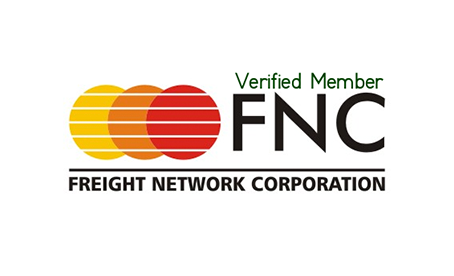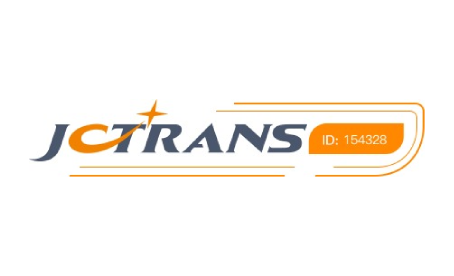There are various methods of shipping cars by sea, between sea freight through RORO ships, which allow shipping many cars on the deck of those ships according to the size of the cars and the surface area of the ship, and the other method of sea freight through containers that vary in length between 20 and 40 feet.
And the number of cars that are loaded inside one container varies according to the area of the container, and in this article, we will explain how many cars can be loaded inside those containers.
Container sizes
Most shipping containers are either 20 feet or 40 feet in length, however, some can be 10 feet, and there are customizable sizes as large as 5 feet, or as large as 45 feet.As for width, almost all are 8 feet, and the standard height for most is 8.5 feet. However, containers can be obtained with a slightly higher height of up to 9.5 feet, so you can reserve any container according to the number of cars to be shipped or the type of car that you want to transport.
Cars that can be loaded into each container:
1- For a 20-foot container:
Mostly a 20ft container can hold 1 car but sometimes:The container can be loaded with two standard cars placed from end to end, such as the smart fortwo type, as follows:
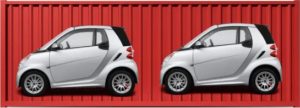
2- For a 40-foot container:
Three to four cars can be loaded in the 40-foot containers. Below are some examples of the cars that can be loaded in those containers:- Loading four cars together into the same container 2 cars loaded in the horizontal position, and above them, 2 cars stuffed on the inclined racks, eg, loading 2 Audi A4 Sedan / Avant + 2 Audi A7 Sportbacks, or 4 BMW 3 Series cars, as in the following figure
- Loading three cars inside the 40-foot container, so that two cars are stuffed in a horizontal position, and on top of one of them a third car is installed on an inclined barrier, such as installing an Audi A4 Allroad car + two Audi E-Tron cars, as follows:

How to stuff cars inside containers?
Cars are loaded inside containers in one of two positions, either in the horizontal position or the inclined position, as follows:1- Loading the car inside the container in the horizontal position
The vehicle is fixed in the horizontal position inside the container by means of hooks that are attached to the floor of the container and are placed on each side of the vehicle to keep it secure to avoid movement during shipment.For example, we use seven different lengths of wire from 2.5 to 5.5 meters. The wires are tied firmly on the wheels and correctly to prevent the tires from rolling and moving from their places.
The top of the cars is also tied to prevent tipping over during shipment in times of severe weather or wind. turbulence, like the following figure:
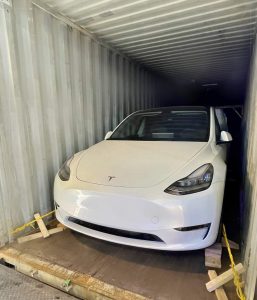
2- Loading cars on horizontal or inclined racks
An interior racking system can be used to load cars inside the container, it is a steel frame designed to hold cars securely inside the container, it is called interior racking.There is also another type of shelf, which are external shelves that are usually used for old cars, or cars that are shipped if they are not driveable.
The external loading rack allows the car to be loaded on the shelves outside the container, without the need for a driver to manoeuvre the car and insert it into the shelves internally.
The shelves are easy to install and do not require experience in their installation, and the car must be fixed using tapes so that it does not slip off those shelves, and the following figure shows the horizontal shelves and how to install cars on them using tapes:
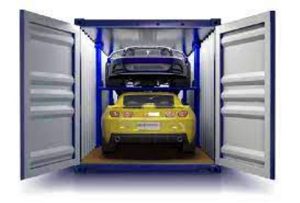
In conclusion, it must be considered that when placing any other shipments next to the car inside the same container, it is better to put barriers to separate the car from other shipments. For this, wooden partitions can be used to separate the car from the rest of the contents of the container, because this is considered safer, and it also facilitates the separation of wooden barriers When unloading, barriers are necessary to prevent scratches or damage to the vehicle if other loads within the container continue to move during transit.


 Track Your Shipment
Track Your Shipment
 Online Enquiry
Online Enquiry
 Sign In
Sign In
 English
English
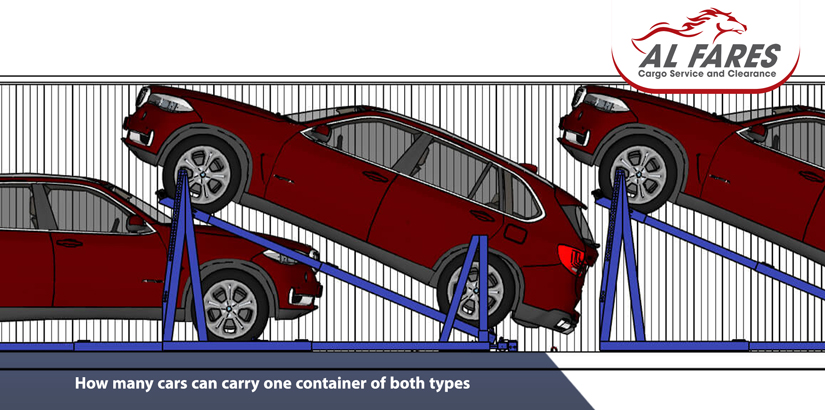
 Alfares Cargo
Alfares Cargo
 Logistic Informations
Logistic Informations
 2023-06-10
2023-06-10







